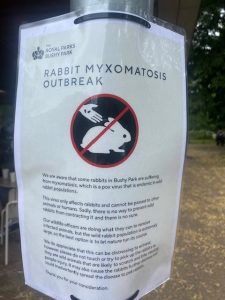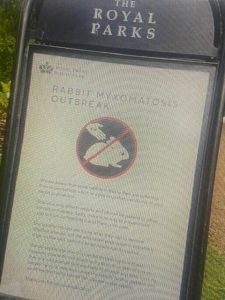BUSHY PARK RABBITS STRUCK BY DISEASE OUTBREAK

Bushy Park rabbits face disease threat

Warning signs in the Park

Don’t touch the rabbits
The wild rabbits of Bushy Park have been hit by the deadly disease, known as Myxomatosis, it was confirmed today.
Warning signs have been placed in the park, specifically in the areas heavily populated with rabbits around the Woodland Gardens and near the Pheasantry Café.
The poster says: “We are aware that some rabbits in Bushy Park are suffering from Myxomatosis, which is a pox virus that is endemic in wild rabbit populations.
“The virus only affects rabbits and cannot be passed to other animals or humans. Sadly, there is no way to prevent wild rabbits from contracting it and there is no cure.
“Our wildlife officers are doing what they can to remove infected animals but the wild rabbit population is extremely large, so the best option is to let nature take its course.
“We do appreciate this can be distressing to witness, however, please do not touch or try to pick up the rabbits as they are wild animals that are likely to scratch and bite, causing people injury.
“It may also cause the rabbits further distress and could inadvertently spread the disease to pet rabbits. Thank you for your consideration.”
According to the local vets, Vet4Life based in Teddington, even indoor rabbits can be at risk and owners are advised to ensure their pets’ vaccinations are up to date.
They offered the following advice:
Q) What are the signs of myxomatosis?
A) It often starts with severe inflammation of the pink bit of the inside of the eyelids (conjunctivitis). Next it will cause swellings of the eyelids, around the head and the genitals. They become increasingly weak, loose their sight and most likely eventually die.
Q) How could my rabbit catch myxomatosis?
A) The main way that pet rabbits catch the virus is by being bitten by an insect that has previously bitten an infected rabbit. These include fleas but also probably midges and mites. Direct contact with an infected rabbit can also spread the disease. All pet rabbits are at risk even indoor rabbits. However, rabbits living outside, especially if they are near to wild rabbits are at greater risk of contracting the disease.
Q) What is the treatment for myxomatosis?
A) There is no specific treatment for this viral disease. Even with good supportive care including fluids, antibiotics, nutrition etc. the prognosis is guarded and unfortunately many rabbits die or are put to sleep.
Q) How can I prevent myxomatosis?
A) Vaccination is the main thing that can prevent your rabbit getting myxo. It can be given from 5 weeks of age and is often given combined with Rabbit Viral Heamorrhagic Disease (RVHD). This vaccination will need to be repeated every year. The vaccination is not 100% effective and vaccinated rabbit can still catch myxo. However, the signs are often mild and rabbits will often recover with appropriate care.
Q) Is there anything else I can do?
A) In addition to the vaccination here are a list of things that can help reduce the risk of your rabbit getting myxomatosis.
- Buy dust extracted hay or kiln-dried grass
- Fit insect screens to outside enclosures
- Remove freestanding water where mosquitoes may breed
- Treat all your pets for fleas
- Ensure wild rabbits do not have access to your garden
- Try to discourage vermin and other wild animals into the outdoor runs and hutches


